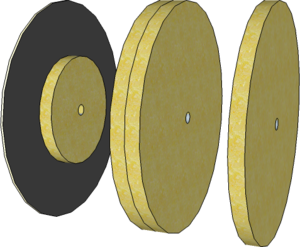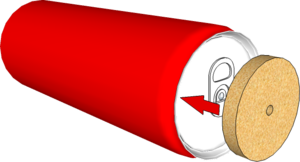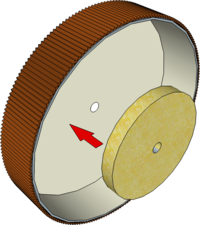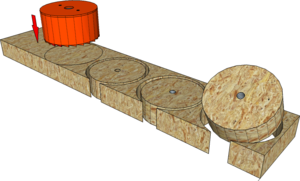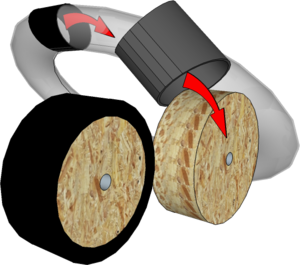Modelling Wheels: Difference between revisions
From DT Online
mNo edit summary |
mNo edit summary |
||
| (2 intermediate revisions by the same user not shown) | |||
| Line 1: | Line 1: | ||
=====Description===== | |||
Wheels for working models are available commercially, often in wood or plastics or as found in '''[[Construction Kits]]''', but they can readily be made from pre-cut discs of '''[[Paper and Card|Card]]''', '''[[Manufactured Board|Ply or MDF]]'''. Alternatively, 'found objects' such as '''[[Stripwood Technology Materials|Cotton Reels]]''' and '''CDs''' can be used. | Wheels for working models are available commercially, often in wood or plastics or as found in '''[[Construction Kits]]''', but they can readily be made from pre-cut discs of '''[[Paper and Card|Card]]''', '''[[Manufactured Board|Ply or MDF]]'''. Alternatively, 'found objects' such as '''[[Stripwood Technology Materials|Cotton Reels]]''' and '''CDs''' can be used. | ||
If there is access to some workshop equipment, they can be cut out from '''[[Manufactured Board]]''' or [ | If there is access to some workshop equipment, they can be cut out from '''[[Manufactured Board]]''' or [http://en.wikipedia.org/wiki/Softwood '''Softwood'''] for example. They can also be cut out by hand using a '''[[Coping Saw]]''' and finished to shape with a '''[[Bench Sanders|Bench Sander]]''', if available - or even 'turned' on a '''[[Centre Lathe|Lathe]]'''! | ||
| Line 17: | Line 18: | ||
---- | ---- | ||
<span style="color: green">'''Note:'''The thin edge of a card disc results in very little [ | <span style="color: green">'''Note:'''The thin edge of a card disc results in very little [http://en.wikipedia.org/wiki/Rolling_resistance| '''Rolling Friction'''] whereas doubling up MDF discs can make wider wheels which have more [http://en.wikipedia.org/wiki/Traction_%28engineering%29'''Traction''']. Which would be best for a balloon powered vehicle and which for those driven through the wheels by an electric motor for example? | ||
</span> | </span> | ||
---- | ---- | ||
| Line 31: | Line 32: | ||
---- | ---- | ||
<span style="color: green">'''Note:''' | <span style="color: green">'''Note:''' | ||
Such large diameter wheels may take more effort to get them the moving but once started are likely to free-wheel for longer. Can you think why this should be so? ''(think about the CD radius being a '''[[:Category:Levers|Lever]]''' and its point of contact with the ground as the '''Fulcrum'''. You may also want to learn about [ | Such large diameter wheels may take more effort to get them the moving but once started are likely to free-wheel for longer. Can you think why this should be so? ''(think about the CD radius being a '''[[:Category:Levers|Lever]]''' and its point of contact with the ground as the '''Fulcrum'''. You may also want to learn about [http://en.wikipedia.org/wiki/Inertia '''Inertia'''] and [http://en.wikipedia.org/wiki/Momentum '''Momentum'''])''. | ||
</span> | </span> | ||
---- | ---- | ||
| Line 40: | Line 41: | ||
Such wide wheels can be seen as a combined wheel and pulley and may easier to locate the drive belt from an electric motor around. They are also useful if modelling a [ | Such wide wheels can be seen as a combined wheel and pulley and may easier to locate the drive belt from an electric motor around. They are also useful if modelling a [http://en.wikipedia.org/wiki/Conveyor_belt '''Conveyor Belt'''] or the feed rollers used in automatic factories and at some supermarket checkouts for example. | ||
| [[File:DrinksCan.png|300px|right]] | | [[File:DrinksCan.png|300px|right]] | ||
|- | |- | ||
| '''Screwtop Jar Lids''' | | '''Screwtop Jar Lids''' | ||
| Typically found as coffee jar lids, these have a deep and serrated rim which can provide good grip ''(or [ | | Typically found as coffee jar lids, these have a deep and serrated rim which can provide good grip ''(or [http://en.wikipedia.org/wiki/Traction_%28engineering%29'''Traction'''])'' if needed. | ||
| Line 70: | Line 71: | ||
|- | |- | ||
| '''Adding a Tyre''' | | '''Adding a Tyre''' | ||
| Bicycle [ | | Bicycle [http://en.wikipedia.org/wiki/Tire#Associated_components '''Inner Tubes'''] can be used to model tyres - and actually provide extra grip. Choose a tube diameter a little less than the finished wheel size and cut into pieces about 2 or 3 times the wheel thickness long. | ||
| Line 83: | Line 84: | ||
| [[File:CopingSawUse.png|300px|right]] | | [[File:CopingSawUse.png|300px|right]] | ||
|} | |} | ||
{{Stripwood Materials Buyers Guide (1)}} | |||
[[Category:Primary Technology]] | [[Category:Primary Technology]] | ||
[[Category:Stripwood Technology]] | [[Category:Stripwood Technology]] | ||
Latest revision as of 09:58, 5 February 2017
Description
Wheels for working models are available commercially, often in wood or plastics or as found in Construction Kits, but they can readily be made from pre-cut discs of Card, Ply or MDF. Alternatively, 'found objects' such as Cotton Reels and CDs can be used.
If there is access to some workshop equipment, they can be cut out from Manufactured Board or Softwood for example. They can also be cut out by hand using a Coping Saw and finished to shape with a Bench Sander, if available - or even 'turned' on a Lathe!
Using Pre-cut Materials
| Card and MDF Discs | Pre-cut discs of Card, Ply or MDF can be purchased and either used separately or glued together with PVA to make wheels in a range of diameters and widths.
Note:The thin edge of a card disc results in very little Rolling Friction whereas doubling up MDF discs can make wider wheels which have more Traction. Which would be best for a balloon powered vehicle and which for those driven through the wheels by an electric motor for example? |
Found Objects
| CDs and Cotton Reels | CDs can be used but first need to have the large centre hole reduced to accept a Dowel Axle. Plastics centres are commercially available but a small diameter MDF disc can be used to solve the problem. Alternatively, a cotton reel can be used as shown.
Note: Such large diameter wheels may take more effort to get them the moving but once started are likely to free-wheel for longer. Can you think why this should be so? (think about the CD radius being a Lever and its point of contact with the ground as the Fulcrum. You may also want to learn about Inertia and Momentum). |
|
| Soft Drinks Can | Empty soft drinks cans may be used to make roller-type wheels and Pulleys. Provision to locate the Dowel Axle needs to made in a similar way as for CDs.
|
|
| Screwtop Jar Lids | Typically found as coffee jar lids, these have a deep and serrated rim which can provide good grip (or Traction) if needed.
|
|
|
Note: If CDs, cotton reels, plastics lids or drinks cans are used, card or MDF discs would have to be glued to them using Double-Sided Tape, an Adhesive such as epoxy resin or Glue Gun since PVA would be ineffective. | ||
Cutting Out Circles
| Using a Holesaw | If there is access to some basic workshop equipment (e.g. a Drilling Machine in a neighbouring secondary school) wheels can be cut from a varety of materials using a Hole Saw. Alternatively, older students or adults could use this in a Power Drill providing the workpiece is securely clamped to the workbench.
|
|
| Adding a Tyre | Bicycle Inner Tubes can be used to model tyres - and actually provide extra grip. Choose a tube diameter a little less than the finished wheel size and cut into pieces about 2 or 3 times the wheel thickness long.
|
|
| Using a Coping Saw | These have a replaceable fine tooth blade which can be adjusted to different angles using pegs and tensioned by tightening the handle.
|
Notes:
- MDF Discs which are pre-drilled are most useful if available, otherwise this might be done as preparation before using with younger children - alternatively a Hand Drill Stand could be used (if neccessary, adults or older children can cut them out of strips of MDF or Ply using a Holesaw).
- Dowels 4mm, 5mm, and 6mm are useful sizes for axles.
- Florist Wire is easily bent into shape whereas stiff wire, such as Brass Brazing Rod, is more suitable for connecting rods.
